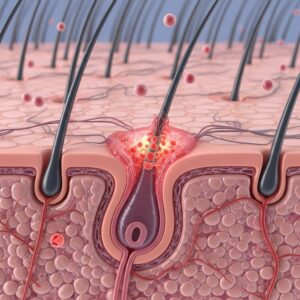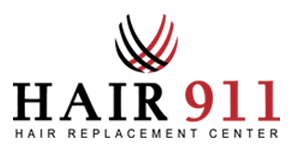Hair 911 Pros: FUE Hair Transplant & Hair Loss Solutions | Inland Empire
The Hidden Culprit: How Inflammation Fuels Hair Loss (And What You Can Do About It)
We often think of hair loss as a straightforward issue—genetics, hormones, or perhaps a lack of the right nutrients. But what if there’s a silent, persistent enemy at play, one that’s constantly sabotaging your hair follicles from within? We’re talking about inflammation.
At Hair911Pros.com, we see firsthand how the intricate balance of your body impacts hair health. And increasingly, research points to chronic inflammation as a significant, often overlooked, factor in various forms of hair loss, from androgenetic alopecia (pattern baldness) to telogen effluvium and even autoimmune conditions like alopecia areata.
The Inflammatory Connection: What’s Happening Under Your Scalp?
Inflammation is your body’s natural response to injury or infection. It’s a crucial part of the healing process. However, when inflammation becomes chronic—persisting over weeks, months, or even years—it shifts from protective to destructive.
In the context of hair loss, chronic inflammation can manifest in several ways:
Damaged Follicles: Persistent inflammation can directly damage hair follicles, leading to miniaturization (shrinking of the follicle) and eventually, the inability to produce healthy hair strands.

Impaired Blood Flow: Inflammation can constrict blood vessels, reducing the supply of essential oxygen and nutrients to the hair follicles, which are vital for hair growth.
Disrupted Hair Growth Cycle: The hair growth cycle has distinct phases (anagen, catagen, telogen). Inflammation can prematurely push hair follicles into the resting (telogen) phase, leading to increased shedding.
Autoimmune Response: In conditions like alopecia areata, the immune system mistakenly attacks healthy hair follicles, leading to patchy hair loss. Inflammation is a central player in this autoimmune response.
Oxidative Stress: Chronic inflammation often goes hand-in-hand with increased oxidative stress, which can further damage cellular structures, including those in hair follicles.
What Fuels Inflammation (and Your Hair Loss)?
Several factors can contribute to chronic inflammation in the body:
Poor Diet: A diet high in processed foods, sugar, and unhealthy fats can trigger systemic inflammation.
Stress: Chronic psychological stress can elevate cortisol levels, which in turn can promote inflammation.
Environmental Toxins: Exposure to pollutants and certain chemicals can contribute to an inflammatory burden.
Gut Imbalance: An unhealthy gut microbiome can lead to a “leaky gut,” allowing inflammatory substances to enter the bloodstream.
Underlying Health Conditions: Conditions like insulin resistance, thyroid disorders, and autoimmune diseases often involve chronic inflammation.
Fighting Back: Strategies to Reduce Inflammation and Promote Hair Growth
The good news is that by addressing the root causes of inflammation, you can create a more hospitable environment for hair growth. Here’s how:
Embrace an Anti-Inflammatory Diet:
Load up on whole foods: Fruits, vegetables, lean proteins, and healthy fats.
Prioritize Omega-3s: Found in fatty fish (salmon, mackerel), flaxseeds, and walnuts, these are powerful anti-inflammatory agents.
Include Antioxidants: Berries, leafy greens, and colorful vegetables help combat oxidative stress.
Limit inflammatory foods: Reduce intake of refined sugars, trans fats, and highly processed foods.
Manage Stress Effectively:
Incorporate stress-reducing practices like meditation, yoga, deep breathing exercises, or spending time in nature.
Ensure adequate sleep, as sleep deprivation can increase inflammation.
Optimize Gut Health:
Consume fermented foods (kefir, sauerkraut, kimchi) and prebiotic-rich foods (onions, garlic, bananas) to support a healthy gut microbiome.
Consider a high-quality probiotic supplement if recommended by a healthcare professional.
Targeted Treatments for Hair Regrowth:
Beyond lifestyle changes, advanced treatments can directly support hair follicle health and stimulate growth, especially when inflammation has taken its toll.
Platelet-Rich Plasma (PRP) Therapy: PRP involves drawing a small amount of your own blood, processing it to concentrate the platelets (which are rich in growth factors), and then injecting this plasma into the scalp. These growth factors can:
Reduce inflammation in the scalp.
Stimulate dormant hair follicles.
Improve blood supply to the scalp.
Extend the anagen (growth) phase of the hair cycle.
PRP is a fantastic option for those experiencing thinning hair and early to moderate hair loss, working with your body’s natural healing mechanisms.
Follicular Unit Extraction (FUE) Hair Transplant: For more advanced cases of hair loss where follicles are permanently lost, FUE hair transplantation offers a lasting solution. This minimally invasive procedure involves individually extracting healthy hair follicles from a donor area (usually the back or sides of the head) and transplanting them to the thinning or balding areas. FUE is a highly effective way to restore natural-looking hair density.
Take Control of Your Hair Health
Understanding the connection between inflammation and hair loss is the first step towards a healthier scalp and fuller hair. At Hair911Pros.com, we offer a comprehensive approach for clients in Riverside, Redlands, Rancho Cucamonga, Ontario, and Palm Springs, combining advanced treatments like PRP and FUE with personalized advice on lifestyle modifications to address the root causes of your hair loss.
Don’t let inflammation silently sabotage your hair. Contact Hair911Pros.com today for a personalized consultation in the Riverside, Redlands, Rancho Cucamonga, Ontario, and Palm Springs area and take the first step towards reclaiming your hair and your confidence!


